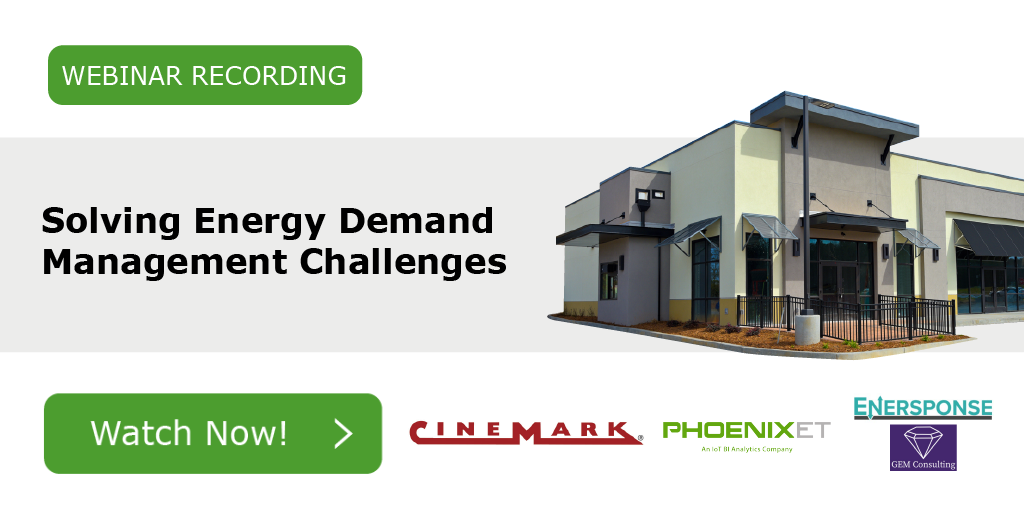Share this
[Webinar Recording] How to Make the Best Energy Decisions with Automated Demand Response
by Phoenix Energy Technologies on Feb 14, 2022
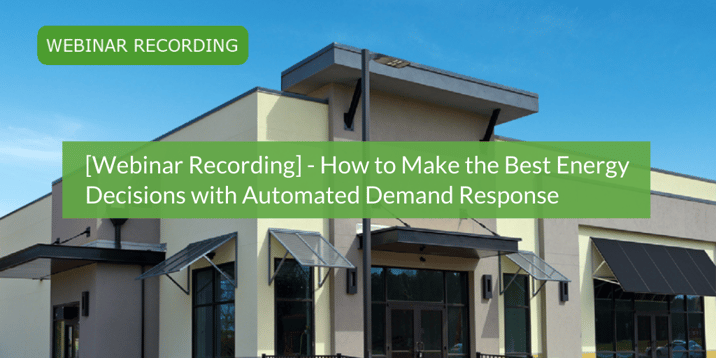
[Webinar Recording] We were recently joined by enterprise energy experts in an exceptional webinar detailing how you can take advantage of demand response relationships ahead of the next demand response season this summer. Read the synopsis here.

Our webinar panel comprised of:
- Ryan Adelman, VP of Business & Corporate Dev, PhoenixET
- Colin Greer, Principal, GEM Consulting
- James McPhail, CEO, Enersponse
- Art Justice, VP of Energy & Sustainability, Cinemark
The primary goal of the discussion was to present the options open to enterprises with demand response, the benefits of automating DR, and to share examples of this in practice, which Cinemark's Art Justice was instrumental in doing.
Download the Webinar Recording!
The panel began by discussing how demand response (DR) partnerships work and how they offer enterprise-level companies an opportunity to reduce energy usage and costs by working with either a utility or grid-level authority. A demand response program allows companies to:
- Respond to market prices
- Earn revenue
- Save budget
- Avoid costs
Flexible Demand Response Meets Company Needs
The panel goes on to talk about how participation in any demand response (DR) program begins by implementing site-level controls and a centralized command structure for all locations. Automated demand response management programs define flexibility and effectiveness with the controls and structure in place. Applying emerging technology provides the flexibility and precision needed to manage peak demand.
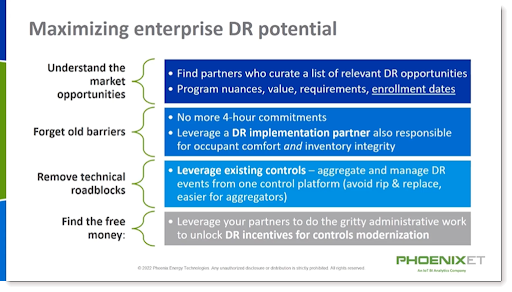
It is noted that effectiveness occurs through a greater efficiency of scale. The convergence of automated DR with technologies like PhoenixET allows companies to merge DR participation with a comprehensive demand management strategy covering all locations. An optimized DR program:
- Matches capabilities with needs
- Drives additional cost savings
- Translates into long-term benefits
Automated Demand Response Integrates With Strategy
The panel continues discussion on the flexibility of demand response, which provides many strategic opportunities. With the ability to tailor automated DR to multi-site organizations, companies can align their demand management programs with established requirements, budgetary restrictions, and corporate-wide strategies. Regardless of the utility, companies can achieve demand management savings.
In addition, companies can build their automated DR program into their ESG/Sustainability strategies. Technology-driven DR programs:
- Stabilize the grid
- Enhance grid resiliency
- Assist with reducing emissions
Demand Response Partnerships Soothes the Pain Points
The panel also discusses how companies can choose to utilize manual demand response programs. However, with that comes the burden of managing demand. Internal support teams are responsible for acting after receiving the utility or grid notification implementing the controls and changes into an energy management system.
Although cost savings may seem apparent, managing demand for multi-site locations can cause problems. While administrative costs increase with complexity, the actual price of manual demand response programs exists within the potential loss of customer comfort.
The benefits of automated demand response partnerships contrast with the difficulties of manually managing demand response. At one level, administrative costs remain under control regardless of the duration of an event. Once the utility or grid-level authority issues the demand notification, enterprise-level energy management applications make automatic changes to curtail load automatically.
At another level, the ability to customize demand response builds customer satisfaction. ADR partnerships can tailor programs to the capabilities of the customer. Individual stores can adjust temperatures and electricity use according to their needs.
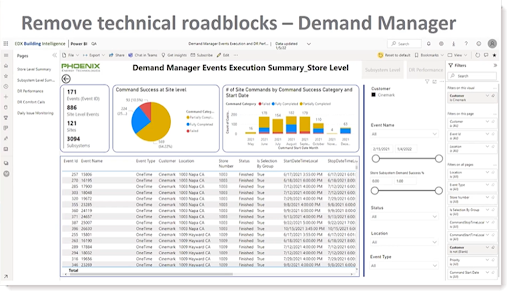
Automated demand response can enable load cycling in HVAC systems, cycle case door heaters, and increase refrigeration suction pressure as needed. Rather than managing demand through a commitment to an arbitrary energy usage amount, a DR partnership allows companies to set the requirements that trigger an automated demand response. An effective energy management system:
- Monitors demand response signals
- Tracks peak load demand
- Relieves exposure to real-time market prices
Automated Demand Response Leverages Your Investment
Finally, the panel talks about how automated demand response relationships reduce stress through ease of use. Dashboard views show portfolios of sites, forecast weather conditions, indicate demand response conditions and provide impact summaries.
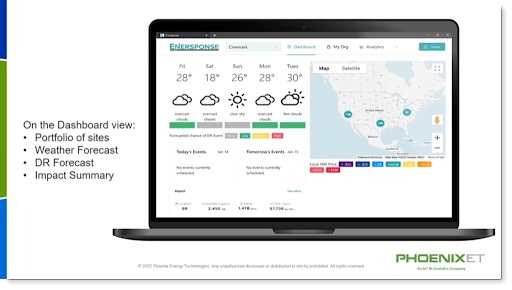
Customer success stories are shared to describe how automated DR partnerships prioritize customer comfort while helping to increase revenues and avoid costs. Energy managers can track all facets of demand response while monitoring market prices.
Solving Energy Demand Management Challenges
The webinar includes Q&A questions, however, as time did not permit, some questions were answered following the event by GEM Consulting's Colin Greer and Enersponse's James McPhail. Those questions and answers are below:
WEBINAR Q: How is demand response participation different if you have multiple controls/EMS vs. one system?
Colin Greer, Principal, GEM Consulting: The curtailment process is duplicated for each EMS, creating more opportunities for something to go wrong vs. one batch push in one system. Technology solutions to combine multiple EMS into one platform replicate one system for curtailment purposes.
James McPhail, CEO, Enersponse: The goal is to see no difference, if possible. By leveraging Phoenix Demand Manager, Enersponse can send one signal that is then pushed to various systems simultaneously. If a participant were not using Demand Manager, Enersponse would be sending simultaneous event signals through APIs to the various systems.
WEBINAR Q: Are there financial penalties if you do not curtail in a DR program?
CG: Usually, no, a good CSP will ensure the contract has protections against penalties.
JM: There are no penalties, costs, or downside. The worst-case scenario is the potential to earn less revenue than expected due to less performance than expected, but never pay a fee or penalty.
WEBINAR Q: What kind of information is needed from the customer to enroll?
CG: Site list with address, utility bill information (annual cost, usage, max demand).
JM: This can be a simple export from your utility bill management system, including Store #, address, utility vendor name, account number, max annual demand (kW), and annual usage (kWh). We can provide a portfolio-level estimate of potential annual earnings/savings with this information.
WEBINAR Q: Do you need utility-grade meters on location to participate
CG: Sometimes, it depends on the market. CSP can help solve issues with metering requirements.
JM: In most markets, you can participate with your existing utility meter and do not need to install any additional metering. In the few markets where your utility meter may not be adequate, secondary metering can be provided.
WEBINAR Q: Can you explain the difference between the offers on your website: Demand Response vs. Management?
JM: Demand Response is activated when a Demand Response program event is initiated and pays for participation, whereas Demand Management is important all the time and can be a major cost savings.
WEBINAR Q: What is typical ROI and store enterprise size recommendation? 50 stores or more?
CG: Up-front investment is usually not required.
JM: There should be no investment required, though some Demand Response providers charge for metering and/or enabling automation.
WEBINAR Q: Regarding government rebates, does James help with this?
JM: Enersponse helps with Auto-DR rebates, which can be used on adding/upgrading controls, and/or implementing a service like Phoenix Demand Manager.
WEBINAR Q: Is there any kind of ranking of states that are the most advantageous for these incentives, a "no brainer" list of sorts...?
CG: Yes, however this is best shared over a discussion with the client about curtailment potential.
JM: California is a no-brainer if you're looking for rebates, but there are financial incentives across the country which we can prioritize for you based on the earnings potential of your portfolio.
WEBINAR Q: Is the verification of demand reduction done through Phoenix, or is that done by the grid or utility directly?
JM: Verification of the demand reduction activities taking place is verified by Phoenix, while the verification of energy reduction is done through the CSP (Enersponse) and/or the utility.
WEBINAR Q: (We) recently engaged in a DR pilot program (summer 2021.) My company managed the manual dispatch DR for 5-10 grocery stores, but this was extremely cumbersome. There have been significant issues in getting into the architecture of Emerson and Danfoss to automate these dispatches. We have an unfortunate amount of experience with failed universal data enterprise systems... Do you have experience working with the Emerson and Danfoss controls systems?
JM: We have extensive experience working with Emerson, and are quite familiar with Danfoss. While Danfoss will want to treat demand response as a managed service, Emerson supports Auto-DR, with whom we have an API. Best for Phoenix (Ryan or Michael) to weigh in on this one based on another active project involving Danfoss.
WEBINAR Q: Do you need utility grade meters on location to participate. If not how is -conformance verified?
JM: Meter requirements vary by market/utility. In most markets, the utility meter you already have is enough. In others, a secondary meter may be required. Conformance is part of the qualification process after receiving a site list with utility account numbers.
WEBINAR Q: Reduction: You agreed to do X when signaled, but you didn't do it ... or, as far as we can tell, you didn't do it. (your demand level did not drop sufficiently)
JM: Don't get stuck with a firm commitment to a kW reduction per site. Every site will perform differently, and most demand response providers will hold you accountable to "X" per location. We don't do that, as it only makes the process more difficult and frustrating to participants. If actions were executed, then "X" is the result of those actions, which will vary by month/day/event.
Check out the full webinar presentation and discussion to learn more! Start learning how you can access the benefits of an automated demand response partnership before the next demand response season!
Share this
- Facilities Management (91)
- Energy Management (69)
- Company News (49)
- Smart Buildings (37)
- Retail (36)
- Building Management (24)
- Building Automation Systems (21)
- Sustainability (20)
- Energy Demand Management (19)
- EEI (15)
- Adaptive Energy Management (14)
- Grocery (14)
- demand response (14)
- Artificial Intelligence (12)
- Data Integration and Visibility (10)
- HVAC IQ (9)
- COVID-19 (8)
- Customer Spotlight (8)
- Carbon Management (7)
- Setpoints and Temperatures (7)
- Equipment Maintenance (6)
- Operational Efficiency (6)
- Refrigeration Optimization (6)
- Ask Ron (5)
- Asset Manager (5)
- Finance and Procurement (5)
- IoT and Digital Transformation (5)
- Awards (4)
- Comfort (4)
- Energy & Store Development (4)
- Safety and Compliance (4)
- Demand Charge Management (3)
- Energy Management System (3)
- Lifecycle Asset Management (3)
- Premium Services (3)
- Refrigeration IQ (3)
- Automated Demand Response (2)
- ConnexFM (2)
- Customer Service (2)
- HVAC Vendor Management (2)
- Load Shedding (2)
- Technician View (2)
- AIM Act (1)
- ALD (1)
- Analytics (1)
- Data (1)
- Data Integration and Visualization (1)
- EMS (1)
- Knowledge Center (1)
- OSHA (1)
- asset management (1)
- December 2025 (1)
- November 2025 (1)
- October 2025 (2)
- September 2025 (1)
- August 2025 (3)
- July 2025 (1)
- June 2025 (1)
- May 2025 (2)
- March 2025 (2)
- February 2025 (1)
- January 2025 (2)
- December 2024 (2)
- October 2024 (1)
- September 2024 (1)
- August 2024 (2)
- June 2024 (2)
- April 2024 (2)
- March 2024 (2)
- January 2024 (1)
- December 2023 (1)
- October 2023 (2)
- September 2023 (2)
- August 2023 (2)
- July 2023 (1)
- May 2023 (2)
- April 2023 (2)
- March 2023 (3)
- February 2023 (1)
- January 2023 (1)
- December 2022 (1)
- November 2022 (2)
- October 2022 (2)
- September 2022 (1)
- May 2022 (2)
- April 2022 (1)
- March 2022 (3)
- February 2022 (2)
- January 2022 (4)
- December 2021 (2)
- November 2021 (3)
- October 2021 (1)
- September 2021 (3)
- August 2021 (4)
- July 2021 (1)
- June 2021 (2)
- May 2021 (1)
- January 2021 (2)
- December 2020 (2)
- November 2020 (2)
- October 2020 (3)
- September 2020 (4)
- August 2020 (3)
- July 2020 (2)
- June 2020 (3)
- May 2020 (3)
- April 2020 (5)
- March 2020 (5)
- February 2020 (4)
- January 2020 (4)
- December 2019 (4)
- November 2019 (3)
- October 2019 (4)
- September 2019 (5)
- August 2019 (4)
- July 2019 (4)
- May 2019 (2)
- April 2019 (3)
- February 2019 (1)
- December 2018 (1)
- November 2018 (1)
- October 2018 (3)
- September 2018 (3)
- August 2018 (3)
- July 2018 (3)
- June 2018 (3)
- May 2018 (1)
- June 2015 (1)
- March 2013 (1)
- January 2013 (1)
- December 2011 (1)
- October 2011 (1)
- September 2011 (1)


